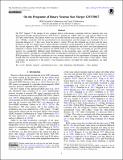On the Progenitor of Binary Neutron Star Merger GW170817
Author(s)
LIGO Scientific Collaboration; Virgo Collaboration; Aggarwal, Nancy; Barsotti, Lisa; Biscans, Sebastien; Buikema, Aaron; Demos, Nicholas; Donovan, Frederick J; Eisenstein, Robert Alan; Essick, Reed Clasey; Evans, Matthew J; Fernandez Galiana, Alvaro-Miguel; Fritschel, Peter K; Gras, Slawomir; Hall, Evan D.; Katsavounidis, Erotokritos; Kontos, Antonios; Lanza Jr, Robert K; Lynch, Ryan Christopher; MacInnis, Myron E; Martynov, Denis; Mason, Kenneth R; Matichard, Fabrice; Mavalvala, Nergis; McCuller, Lee P; Miller, John; Mittleman, Richard K; Ray Pitambar Mohapatra, Satyanarayan; Shoemaker, David H; Tse, Maggie; Vitale, Salvatore; Weiss, Rainer; Yu, Hang; Yu, Haocun; Zucker, Michael E; ... Show more Show less
DownloadAbbott_2017_ApJL_850_L40.pdf (3.113Mb)
PUBLISHER_CC
Publisher with Creative Commons License
Creative Commons Attribution
Terms of use
Metadata
Show full item recordAbstract
On 2017 August 17 the merger of two compact objects with masses consistent with two neutron stars was discovered through gravitational-wave (GW170817), gamma-ray (GRB 170817A), and optical (SSS17a/AT 2017gfo) observations. The optical source was associated with the early-type galaxy NGC 4993 at a distance of just ∼40 Mpc, consistent with the gravitational-wave measurement, and the merger was localized to be at a projected distance of ∼2 kpc away from the galaxy's center. We use this minimal set of facts and the mass posteriors of the two neutron stars to derive the first constraints on the progenitor of GW170817 at the time of the second supernova (SN). We generate simulated progenitor populations and follow the three-dimensional kinematic evolution from binary neutron star (BNS) birth to the merger time, accounting for pre-SN galactic motion, for considerably different input distributions of the progenitor mass, pre-SN semimajor axis, and SN-kick velocity. Though not considerably tight, we find these constraints to be comparable to those for Galactic BNS progenitors. The derived constraints are very strongly influenced by the requirement of keeping the binary bound after the second SN and having the merger occur relatively close to the center of the galaxy. These constraints are insensitive to the galaxy's star formation history, provided the stellar populations are older than 1 Gyr.
Date issued
2017-12Department
Massachusetts Institute of Technology. Department of Physics; MIT Kavli Institute for Astrophysics and Space Research; LIGO (Observatory : Massachusetts Institute of Technology)Journal
Astrophysical Journal. Letters
Publisher
IOP Publishing
Citation
Abbott, B. P. et al. “On the Progenitor of Binary Neutron Star Merger GW170817.” The Astrophysical Journal 850, 2 (December 2017): L40 © 2017 The American Astronomical Society
Version: Final published version
ISSN
2041-8213
2041-8205